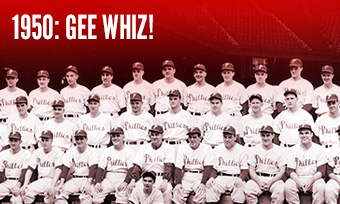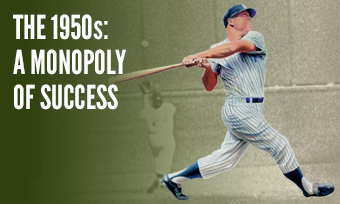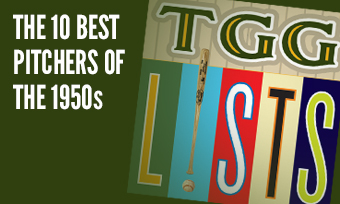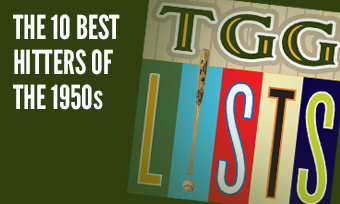The Yearly Reader
Leaders and Honors, 1950
Our list of baseball’s top 10 hitters and pitchers in both the American League and National League for the 1950 baseball season, as well as the awards and honors given to the game’s top achievers of the year.
The National League’s Top 10 Hitters, 1950
Bold type in brick red indicates league leader.
1. Stan Musial, St. Louis
Key Numbers: .346 average, 105 runs, 192 hits, 41 doubles, 7 triples, 28 home runs, 109 RBIs, 87 walks, .596 slugging percentage.
Musial remained the NL’s most dangerous hitter by taking his first of three straight batting crowns while also leading in slugging percentage; his 30-game hitting streak was also the longest of his career.
2. Ralph Kiner, Pittsburgh
Key Numbers: .272 average, 112 runs, 21 doubles, 6 triples, 47 home runs, 118 RBIs, 122 walks, 19 intentional walks.
Kiner became the first NL player to belt 100 home runs over two seasons.
3. Duke Snider, Brooklyn
Key Numbers: .321 average, 109 runs, 199 hits, 31 doubles, 10 triples, 31 home runs, 107 RBIs, 16 stolen bases.
A year after belting 15 of 23 homers on the road, Snider figured out the atmospherics of Ebbets Field and began a stretch of eight straight seasons in which he’d hit more at home.
4. Del Ennis, Philadelphia
Key Numbers: .311 average, 92 runs, 185 hits, 34 doubles, 8 triples, 31 home runs, 126 RBIs, 25 grounded into double plays.
As the prime offensive mover for the pennant-winning Phillies, Ennis was never better—but he finished fourth in the MVP vote behind teammate Jim Konstanty, Musial and, yes, Eddie Stanky.
5. Andy Pafko, Chicago
Key Numbers: .304 average, 95 runs, 24 doubles, 8 triples, 36 home runs, 92 RBIs.
The Cubs’ slugger of the day collected more home runs (36) than strikeouts (32).
6. Jackie Robinson, Brooklyn
Key Numbers: .328 average, 99 runs, 170 hits, 39 doubles, 4 triples, 14 home runs, 81 RBIs, 80 walks, 12 stolen bases.
Robinson was in line for a second straight batting title—hitting .370 at the start of August—before a prolonged slump took him down.
7. Earl Torgeson, Boston
Key Numbers: .290 average, 120 runs, 167 hits, 30 doubles, 23 home runs, 87 RBIs, 119 walks, 15 stolen bases.
Torgeson snuck in a quality performance before the painful after-effects of a 1949 shoulder injury quelled the rest of his career.
8. Sid Gordon, Boston
Key Numbers: 134 games, .304 average, 33 doubles, 27 home runs, 103 RBIs, 78 walks.
Traded from the Giants as part of a six-player deal, Gordon became a reliable rock in the Braves’ lineup during the team’s final, downward spiral of a few years at Boston.
9. Eddie Stanky, New York
Key Numbers: .300 average, 115 runs, 25 doubles, 5 triples, 8 home runs, 51 RBIs, 144 walks, 12 hit-by-pitches, .460 on-base percentage.
One of the other players headed the other way in the Gordon trade, Stanky predictably led the NL in walks, hit-by-pitches—and ejections (a career-high six).
10. Bob Elliott, Boston
Key Numbers: .304 average, 94 runs, 162 hits, 28 doubles, 5 triples, 24 home runs, 107 RBIs.
The veteran slugger knocked in 100-plus runs for the sixth and final time.
The American League’s Top 10 Hitters, 1950
1. Walt Dropo, Boston
Key Numbers: 136 games, .322 average, 101 runs, 180 hits, 28 doubles, 8 triples, 34 home runs, 144 RBIs.
Dropo came within one RBI of tying teammate Ted Williams’ rookie mark of 11 years earlier, and was the last player until George Brett in 1980 to average more than one ribbie per game. All that, and not only did he not win the AL MVP, but he finished second among Red Sox players, as utility guy Billy Goodman (who hit .354 in 110 games) somehow garnered more votes.
2. Yogi Berra, New York
Key Numbers: .322 average, 116 runs, 192 hits, 30 doubles, 6 triples, 28 home runs, 124 RBIs.
If Yogi’s world was perfect, it wouldn’t be. It was perfect enough in 1950. In 656 plate appearances, he struck out just 12 times.
3. Joe DiMaggio, New York
Key Numbers: .301 average, 114 runs, 33 doubles, 11 triples, 32 home runs, 122 RBIs, 81 walks, .585 slugging percentage.
At age 35, the Yankee Clipper turned in his last solid set of numbers, and he continued to get hosed at Yankee Stadium with its ultra-distant left field dimensions; only nine of his 32 homers were hit there.
4. Larry Doby, Cleveland
Key Numbers: .326 average, 110 runs, 25 doubles, 5 triples, 25 home runs, 102 RBIs, 104 walks, .442 on-base percentage.
It took a few years for Doby, but the forgotten man in the shadow of Jackie Robinson as the AL’s first black player finally earned star recognition. Helping to that end was a three-homer performance on August 2, the first by an African-American player.
5. Vern Stephens, Boston
Key Numbers: .295 average, 125 runs, 185 hits, 34 doubles, 6 triples, 30 home runs, 144 RBIs.
Stephens virtually matched Walt Dropo in the power numbers and, like most Red Sox hitters of the time, fully embraced Fenway Park—hitting 100 points higher there than on the road.
6. Vic Wertz, Detroit
Key Numbers: .308 average, 99 runs, 172 hits, 37 doubles, 4 triples, 27 home runs, 123 RBIs, 95 walks, 8 intentional walks.
Four Detroit hitters scored over 100 runs each, and they had RBI machine Wertz mostly to thank.
7. George Kell, Detroit
Key Numbers: 157 games, .340 average, 641 at-bats, 114 runs, 218 hits, 56 doubles, 6 triples, 8 home runs, 101 RBIs.
Kell became last AL player to date to knock in 100 runs on less than 10 home runs.
8. Ted Williams, Boston
Key Numbers: 89 games, .317 average, 82 runs, 24 doubles, 28 home runs, 97 RBIs, 82 walks.
It’s frightening to think what kind of numbers Williams would have put up if he hadn’t missed 61 games due to his All-Star Game elbow injury, but here’s what he was on pace for: 47 home runs, 163 RBIs and 138 walks.
9. Hoot Evers, Detroit
Key Numbers: .323 average, 100 runs, 170 hits, 35 doubles, 11 triples, 21 home runs, 103 RBIs, 75 walks.
Along with Vic Wertz and George Kell, Evers—enjoying his third straight year above .300 before chronic injuries derailed his stardom—became part of the last trio of Tigers to each knock in 100+ runs until 1997.
10. Phil Rizzuto, New York
Key Numbers: .324 average, 125 runs, 200 hits, 36 doubles, 7 triples, 7 home runs, 66 RBIs, 99 walks, 19 sacrifice hits, 12 stolen bases.
Rizzuto was usually shortstop first, hitter second—but his superior glovework found a worthy equal in his suddenly hot bat; it was good enough to gain him the AL MVP.
The National League’s Top 10 Pitchers, 1950
1. Jim Konstanty, Philadelphia
Key Numbers: 2.66 ERA, 16 wins, 7 losses, .696 win percentage, 22 saves, 74 appearances, 0 starts, 152 innings, 39 walks.
The stunning, out-of-nowhere MVP reliever would be back to nowhere in the years to follow, never coming close to replicating his 1950 success in a career that would last through 1956.
2. Warren Spahn, Boston
Key Numbers: 3.16 ERA, 21 wins, 17 losses, 41 appearances, 39 starts, 25 complete games, 293 innings, 111 walks, 191 strikeouts.
Spahn began a dynamite decade in which he’d fail to win 20 games only twice; though he’d call Milwaukee home for much of the 1950s, for the moment he was enjoying Boston and Braves Field, where in 1950 he won 14 games (losing five) with a 2.06 ERA.
3. Robin Roberts, Philadelphia
Key Numbers: 3.02 ERA, 20 wins, 11 losses, 40 appearances, 39 starts, 5 shutouts, 304.1 innings, 33 grounded into double plays.
Like Spahn, Roberts entered his peak period by recording the first of six straight 20-win seasons, though it took him five starts to get #20.
4. Sal Maglie, New York
Key Numbers: 2.71 ERA, 18 wins, 4 losses, .818 win percentage, 47 appearances, 16 starts, 5 shutouts.
Maglie could thank the Mexican League that had him briefly blacklisted in America for making him a better pitcher, learning the curve from 1920s star Dolf Luque south of the border.
5. Ewell Blackwell, Cincinnati
Key Numbers: 2.97 ERA, 17 wins, 15 losses, 40 appearances, 32 starts, 261 innings, 104 walks, 188 strikeouts, 11 wild pitches, 13 hit-by-pitches.
Blackwell’s 17 wins didn’t include the one he gained credit for in the All-Star Game—making his fifth of six straight appearances in the Midsummer Classic.
6. Larry Jansen, New York
Key Numbers: 3.01 ERA, 19 wins, 13 losses, 40 appearances, 35 starts, 5 shutouts, 275 innings, 55 walks.
Along with Sal Maglie’s 45.2-inning scoreless inning streak, Jansen was one of two Giants on the year with streaks over 30 innings; no pitching duo would do that again until the Dodgers’ Clayton Kershaw and Zack Greinke in 2015.
7. Jim Hearn, St. Louis-New York
Key Numbers: 2.49 ERA, 11 wins, 4 losses, 22 appearances, 16 starts.
All but ignored in St. Louis, the fourth-year right-hander found attention and happiness with the Giants after being claimed on waivers in mid-July.
8. Don Newcombe, Brooklyn
Key Numbers: 3.70 ERA, 19 wins, 11 losses, 40 appearances, 35 starts, 267.1 innings, 34 grounded into double plays.
Losing the 10-inning heartbreaker at season’s end against the Phillies not only denied Newcombe of a 20-win campaign, it also epitomized his struggles against Philadelphia (2-5, 4.40 ERA in eight starts).
9. Max Lanier, St. Louis
Key Numbers: 3.13 ERA, 11 wins, 9 losses, 27 starts, 5 balks.
Curiously, Lanier’s league-leading five balks were his first five since 1941—when he committed a pair to also pace the NL.
10. Vern Bickford, Boston
Key Numbers: 3.47 ERA, 19 wins, 14 losses, 40 appearances, 39 starts, 311.2 innings, 122 walks.
Bickford’s presence in Boston allowed Braves fans to pray less for rain beyond Warren Spahn and Johnny Sain; in fact, he threw the year’s own no-hitter.
The American League’s Top 10 Pitchers, 1950
1. Early Wynn, Cleveland
Key Numbers: 3.20 ERA, 18 wins, 8 losses, .692 win percentage, 213.2 innings, 101 walks.
The 3.20 ERA authored by Wynn, who finally hit peak level 11 years after his major league debut, was the highest ever for a league leader.
2. Ed Lopat, New York
Key Numbers: 3.47 ERA, 18 wins, 8 losses, .692 win percentage, 32 starts, 236.1 innings.
With everyone else named Ed (or Eddie) racking up the walks in the majors, why not have Ed Lopat, a pitcher, get in on the act? In 82 at-bats, he drew 17 bases on balls.
3. Art Houtteman, Detroit
Key Numbers: 3.54 ERA, 19 wins, 12 losses, 41 appearances, 34 starts, 21 complete games, 4 shutouts, 274.2 innings.
In between a fractured skull, a military leave, the tragic auto death of his baby son and records of 2-16 and 8-20, Houtteman scored a career year in his hometown of Detroit.
4. Bob Lemon, Cleveland
Key Numbers: 3.84 ERA, 23 wins, 11 losses, .676 win percentage, 44 appearances, 37 starts, 22 complete games, 288 innings, 146 walks, 170 strikeouts, 14 caught stealing, 36 grounded into double plays.
Lemon led the majors with a career-high 146 walks—but also induced 36 double play grounders, also a major league high for the season.
5. Allie Reynolds, New York
Key Numbers: 3.74 ERA, 16 wins, 12 losses, 35 appearances, 29 starts, 14 complete games, 240.2 innings, 138 walks, 160 strikeouts, 26 grounded into double plays.
The Yankees’ senior ace set career highs in strikeouts and walks, but somewhat made up for the latter by inducing his usual higher-than-average total of double-play grounders.
6. Bill Wight, Chicago
Key Numbers: 3.58 ERA, 10 wins, 16 losses.
Hey Bill, they don’t call the White Sox the Hitless Wonders for nothing; Wight’s deceiving record could be tied to awful support (3.14 runs per start).
7. Vic Raschi, New York
Key Numbers: 4.00 ERA, 21 wins, 8 losses, .724 win percentage, 32 starts, 256.2 innings 116 walks, 6 balks.
Raschi finished the season with seven wins in a row—despite allowing five runs in four of them.
8. Bob Feller, Cleveland
Key Numbers: 3.43 ERA, 16 wins, 11 losses, 34 starts, 247 innings, 103 walks.
Now came the hard part for Feller: Learning to pitch with a faded fastball. He scored high grades despite striking out six or more in just three of his 34 starts.
9. Mel Parnell, Boston
Key Numbers: 3.61 ERA, 18 wins, 10 losses, 40 appearances, 31 starts, 21 complete games, 249 innings, 106 walks.
Winning eight starts in a row down the stretch catapulted Parnell from a so-so-campaign to something a bit more worthy.
10. Ned Garver, St. Louis
Key Numbers: 3.39 ERA, 13 wins, 18 losses, 37 appearances, 31 starts, 22 complete games, 260 innings, 108 walks.
For all it’s worth; Garver is the last pitcher to date to throw a baserunner out from the outfield. How he got there is the question we’d like to ask, too.









